MATCHING YOUR BONSAI TO A POT — PART 2
I must preface my comments: Yuji Yoshimura ‘Miniature Trees and Lanscapes’ 1957 which basically says the tree takes precedence over the pot. But like clothes to humans it should match the tree. The stand, though important is far down the scale of importance. I consider them to be shoes. Nice to have, but not necessary. Try running down the street without clothes and you understand my point. Tree — Pot — Stand. The idea of matching silhouettes on a personal issue is a ghastly thought.
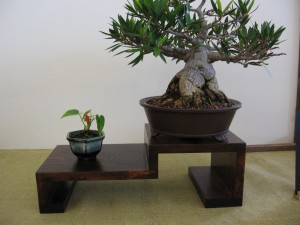
My own beginning to pots might be this favorite of mine. Sadly I use the word loosely. It belongs to Bill S., and well reflects taking inspiration from nature. The following is an exploration of pots, not so much in the study of trees, but in the emotions that are woken when a plants-man senses the ever changing mood of nature.
The time of displays is very important and was one of the reasons I was against a summer display. I fear we will have lost spring, which albeit is cold and wet, but is also the season of fertilization. Of flowers, and pollinization. Observing the signs of the season is always important when displaying bonsai. I tend to be a fall lover myself, so perhaps I am a ginkgo at heart.
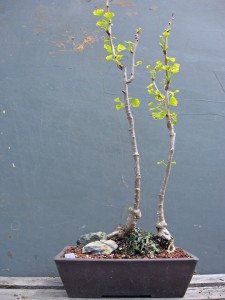
I would also edit the following with one personal observation. FEET. I like pots with good feet, as not only do they add to the pots attractiveness, they help allow better drainage, especially if healed in for winter care. All to often do I find pots with the drainage holes totally flush to the ground. They do not drain! All flat bottomed containers should have blocks put under them so they can drain.
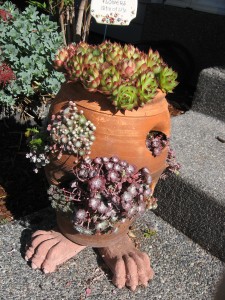
The three masters I recommend are Yuji Yoshimuri, John Naka and Toshio Kawamoto. Anyone fortunate enough to own any of their books is well ahead of the game. I am still trying!
Their recommendations for the shape and color of pots for the basic styles are:
Shape should always relate to the or character of the tree. Straight trunk styles will balance better in a rectangular pot. Curved or soft-line trunk will look better in an oval, round, round-cornered or rectangular pot. Powerful or rugged looking trees such as Pine should be planted in a similar looking pot and their dark green leaves would suggest a dark colored pot.
Unglazed, earthenware pots may be used for ANY Bonsai, and are overwhelmingly preferred for needle-evergreen trees. Glazed pots are most often used for flowering or fruiting tree and the colors should compliment the tree. Pink or red flowers go well in blue, gray or off white pots.
FORMAL UPGRIGHT
Yoshimura: Formal upright CONIFER. Any austere pot, rectangular, square or round. No patterns or decorations. Brown or grayish brown color.
Naka: A straight trunk style will balance better in a rectangular pot.
OTHER UPRIGHT TREES
Naka: In most cases, the length of the pot should be a little more than 2/3 the height of the tree. The width of the pot should be a little narrower than the spread of the longest branches on both sides.
Kawamoto: Trees with massive trunks need comparatively thick and deep pots. My Pines are so planted.
Yoshimura: Tall trees with thin trunks and delicate foliage use more shallow containers and should be planted off center.
Naka: PINES. Especially in regards to the strong-needled black pine — a rectangular or square container, depending on its form. The softer needled red pine is complemented in an oval pot.
“Curved or soft-lined trees: oval, round, round cornered or rectangular pot.
Trees are usually planted off-center. Remember Austere. Brown, Gray, and I would add pale-green or gray would be okay.
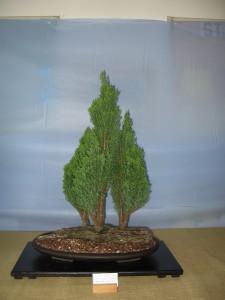
JAPANESE OR KOREAN MAPLES
A fellow enthusiast mentioned that Japanese Maples are feminine in nature so while unglazed pots, be they light gray to medium to dark brown may work, especially with the red leaf or red fall colored forms, the pot should be softly contoured to fit the lady. Deep containers usually defeat the flow. Colors and glazes are also great. I like the off white, cracked and even the light yellow glazes Soft green, gray-green and soft discreet blues work, while brashy cobalt purples would be counter productive. Click on the picture below and tell me what I am.
My own Acer griseum, might be an exception to this rule. I strongly feel that it is a HE and I will bring him along as an example of what not to do, in more ways than one.
MORE THAN ONE TRUNK
CASCADE
Naka: Pot should be deep or tall, In some cases, a medium depth pot can be used, but never plant a cascade in a shallow pot. The length of the tree, from apex to the lowest point, and the height of the pot, should not be the same.
Yoshimura: Cascade (plus semi-cascade, literati, windsweept, twisted trunk) can be displayed in elaborate containers, and brightly glazed for trees with flowers or fruit. Cascade pots can be round, square or hexagonal, Etchings are allowed.
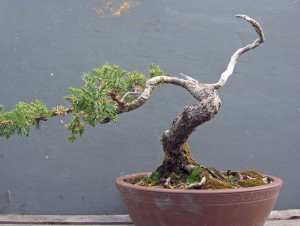
LITERATI
Pots can be small, round and shallow and should not take away from the tree. Handmade pottery can also be used if plain.
MORE ON BRANCH SPREAD FOR EVERGREEN TREES
Using that “watch your branch spread” in a relationship may not work. My now exfoliated partner would agree. Never suggest a 2/3 weight reduction or a return to years long done gone.
The 2/3 rule continues to apply as well as common sense. The trunk of the tree is planted in a position to allow the LONGER bracnches stretching room over the earth it has been given. More complicated are shorties, that is to say … the tree is shorter than its width. In that case the pot size should be 2/3 the width or spread of the tree.
We continue with the austere, but if you do colors anyway: DARK, be it purple, red, gray or dark brown. No glazed.
FOR DECIDUOUS TREES
Now we can get into colors, light blue (robin egg blue, unglazed red, gray, or brown pots are generally used. Even a use for my bright gold pot. My Ginkgo! In general, the depth of the pot should be as close as possible to the thickness of the trunk, except in cascade and multi-turnk trees.
Always note that some deciduous trees need a deeper pot to remain healthy. Pines,Oak and Nothofagus seem to be in this category. One cheat I use is to put tunnels into the soil mix using a dibble stick or pvc pipe (on new plantings.) Into these tunnels I poor in coarse perlite or sharp gravel. This improves both watering and drainage problems. It also allows oxygen to get to the roots.
FOR FLOWERING AND FRUIT TREES.
FINALLY, we get to the greens, and brightly colored and glazed pots. It is important to match the flowering color with the pot. This could be complementary or contrast, in my opinion. Should you do a flower show in the fall, you might try to match the pot to the fruit or berry. Holly and apple come to mind. GLAZE is good. I also am always reminded that a cracked ivory white is always a safe neutral pot to use. It would also be a good color to use for a winter show. This was a beautiful Pear tree and the the proportions of tree to pot are great.
SAIKEI
Miniature landscape plantings as Chris has shown us can be made on slabs or artificial stone pots. They are often shallow and can be long round ovals. This forest picture link of my Garry Oaks is the best I could do.
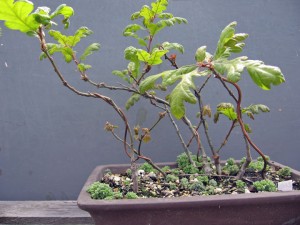
SATSUKI
This would be far better explained by Ron and my one plant would not be a good role model. I would guess that pot shape could be anything as some plants are cascades and others are grown as uprights. Some of the same principals discussed before would apply here as well. You have an exceptionally vibrant R. indicum red. An earthen colored or gray green pot would not clash with the flowers. A mixed color pink white cascade might go well in a rounded heavy pot. Embossing s on the clay would acceptable, but nothing should clash or detract from the flowers. Glazes are fine, as long as they are toned down. Earthen browns or gray-blues suggesting earth and water would be my sense of balance to this form.
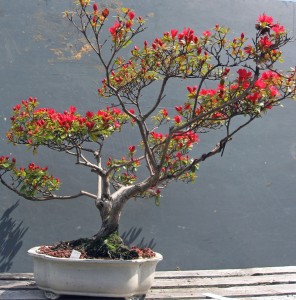
Wisteria would fit in the same mold, as some are trained as uprights and others as weeping cascades.
ACCESSORY PLANTS
Such as Mondo grass, Rockfoil, Blood grass, dwarf Hosta or Astilbe, Bamboo are usually put in shallow earthen bowles but I would not hesitate to use a glazed pot to compliment or contrast the strong colors of say the Blood grass or Golden Bamboo. Check out the color wheel template. Cheap that I am, I offered Bill a discounted price for the blue pot on the right, pointing out the incurved rim. Something that makes transplanting more difficult. Trouble is Bill is even cheaper. That is how he bought the pot. He then inserts a styrafoam collar, to make the sides straight. He graciously offered to throw in the styrafoam.
SUISEKI
Very low trays in which sand has been poured. The tray must be in proportion to the rock. They can also be mounted in daizai, hand made wooden frames, so to speak. I really don’t own a good Suiseki, so I will turn to one of intent. It was framed in a lawn and was to overlook and patrol a seashore pond.
Originally I put 4 such massive slabs in the lawn to overlook the two ponds. On this six foot slab I simply had to add some feet and a head. We now had an active turtle. In memory of Annie Hofius of Dungeness. Her garden and her life were an inspiration every week.
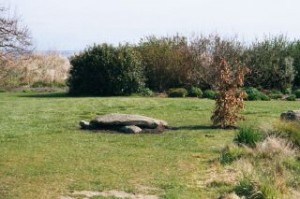
(C) Herb Senft
I strongly recommend obtaining Bonsai Clubs International 1981. A wonderful magazine. The December, 1980 issue has an exceptional article on Japanese pots and kiln marks. From the high quality Tokoname to the mass produced of Yokkaichi City. This could be a lecture all in itself. I would also add that China, Korea and Indonesia would have different attitudes towards pot selection.

Thanks for the great write up. I have shared it
on my social media accounts.